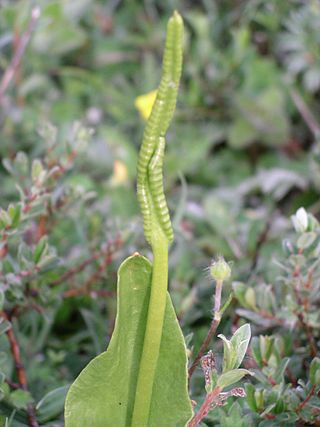
Ophioglossum, the adder's-tongue ferns, is a genus of about 50 species of ferns in the family Ophioglossaceae. The name Ophioglossum comes from the Greek meaning "snake-tongue". Their cosmopolitan distribution is mainly in tropical and subtropical habitats.

Saccharum is a genus of tall perennial plants of the broomsedge tribe within the grass family.
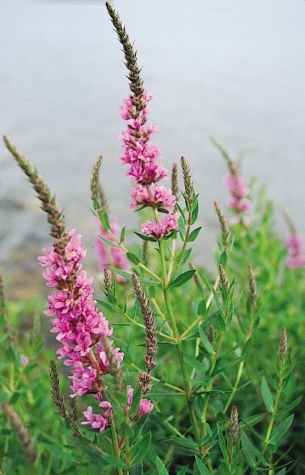
Lythraceae is a family of flowering plants, including 32 genera, with about 620 species of herbs, shrubs, and trees. The larger genera include Cuphea, Lagerstroemia (56), Nesaea (50), Rotala (45), and Lythrum (35). It also includes the members of the former families of the pomegranate and of the water caltrop. Lythraceae has a worldwide distribution, with most species in the tropics, but ranging into temperate climate regions as well.

Lythrum salicaria or purple loosestrife is a flowering plant belonging to the family Lythraceae. It should not be confused with other plants sharing the name loosestrife that are members of the family Primulaceae. Other names include spiked loosestrife and purple Lythrum. This herbaceous perennial is native to Europe and Asia, and possibly Australia.

Lythrum is a genus of 38 species of flowering plants native to the temperate world. Commonly known as loosestrife, they are among 32 genera of the family Lythraceae.
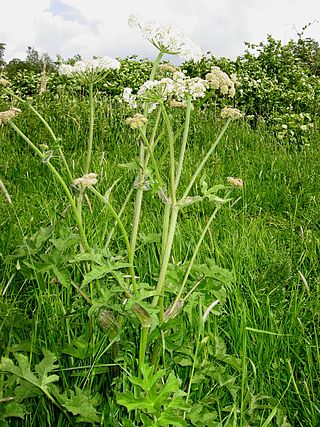
Heracleum sphondylium, commonly known as hogweed or common hogweed, is a herbaceous perennial plant in the carrot family Apiaceae, which includes fennel, cow parsley, ground elder and giant hogweed. It is native to most of Europe, western Asia and northern Africa, but is introduced in North America and elsewhere. Other common names include cow parsnip. The flowers provide a great deal of nectar for pollinators.

Anginon is a genus of flowering plant in the family Apiaceae. It is endemic to southern Africa.
Trigonosciadium is a genus in the family Apiaceae. Trigonosciadium brachytaenium is endemic to Iran, whereas T. tuberosum and T. viscidulum grow in Iran, Anatolia and Iraq.
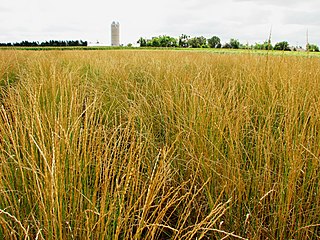
Thinopyrum intermedium, known commonly as intermediate wheatgrass, is a sod-forming perennial grass in the Triticeae tribe of Pooideae native to Europe and Western Asia. It is part of a group of plants commonly called wheatgrasses because of the similarity of their seed heads or ears to common wheat. However, wheatgrasses generally are perennial, while wheat is an annual. It has gained the Royal Horticultural Society's Award of Garden Merit as an ornamental.

Lythrum californicum is a species of flowering plant in the loosestrife family known by the common name California loosestrife. It is native to northern Mexico and the southwestern United States into the Midwest as far east as Oklahoma and Texas. It often grows in moist habitat. This is an erect perennial herb reaching 20 to 60 cm tall, sometimes branching. The waxy linear to lance-shaped leaves are arranged oppositely lower on the plant, and alternately toward the top. They are 1 to 7 cm in length. The inflorescence is a terminal spike of flowers with purple petals under a centimeter long. Flowers are heterostylous on one individual plant, with some having long, protruding styles and some with shorter styles not protruding from the mouth of the flower. The fruit is an oval capsule containing many minute seeds.

Lythrum hyssopifolia is a species of flowering plant in the loosestrife family known by the common names hyssop loosestrife and grass-poly. It is native to Europe but it is known elsewhere, including parts of Australia and eastern and western North America, as an introduced species and sometimes a weed. It is rare in the United Kingdom, with occasional isolated populations. It often grows in moist habitats, such as marshes and wet agricultural fields, rice paddies, for example.

Hylobius transversovittatus is a species of weevil in the family Curculionidae. It is native to the Old World where both adults and larvae feed on purple loosestrife. This plant is regarded as an invasive species in North America and the weevil has been introduced into both the United States and Canada in an effort to control the plant.

Lythrum alatum, commonly known as winged loosestrife, winged lythrum or angled purple-loosestrife, is a species of flowering plant belonging to the family Lythraceae. It is endemic to wetland areas in central and eastern United States and Ontario.
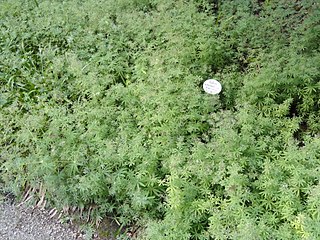
Galium intermedium is a species of plant in the family Rubiaceae. It is native to Central and eastern Europe. It is also reportedly naturalized in Santa Clara County, California.
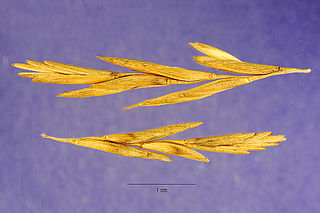
Thinopyrum is a genus of Eurasian and African plants in the grass family.
Thesium linophyllon is a species of flowering plant belonging to the family Santalaceae.

Schistophragma is a genus of flowering plants belonging to the family Plantaginaceae.

Symphyotrichum spathulatum is a species of flowering plant in the family Asteraceae native to western North America including northwestern Mexico. Commonly known as western mountain aster, it is a perennial, herbaceous plant that may reach 20 to 80 centimeters tall. Its flowers, which open in July and August, have violet ray florets and yellow disk florets.
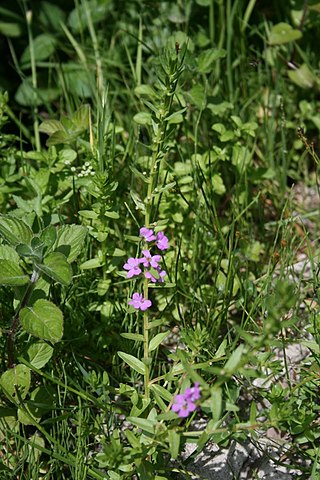
Lythrum junceum is a species of perennial herb in the family Lythraceae native to the Mediterranean Basin, West Asia and Macaronesia. They have a self-supporting growth form and simple, broad leaves. They are associated with freshwater habitat. Individuals can grow to 0.2 m.

Lythrum virgatum, the wand loosestrife, is a species of flowering plant in the family Lythraceae, native to wet areas of the Eurasian steppes, and introduced to France, Germany, and the United States. The unimproved species and a number of cultivars are available from commercial suppliers. It is considered an invasive species in some jurisdictions.

















